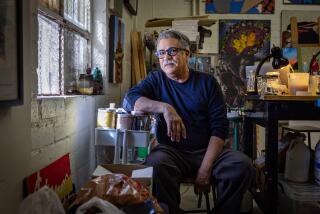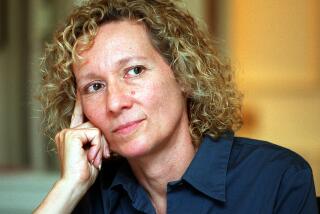Richard Hamilton dies at 89; British Pop Art pioneer
Richard Hamilton, a British Pop Art pioneer who was credited with coining the name for a movement marked by its ironic and iconic use of commercial and pop culture imagery, has died. He was 89.
The Gagosian Gallery, which represents Hamilton, said the artist died Tuesday at an undisclosed location in Britain. It did not give the cause of death.
A painter and printmaker born in London in 1922, Hamilton studied at the Royal Academy Schools and the Slade School of Fine Art.
He made waves with a prescient 1956 collage — “Just What Is It That Makes Today’s Homes So Different, So Appealing?” — that pictured a physically idealized naked couple posing in an interior stuffed with products, logos, and slogans. The male figure, who looked like a body builder, carried a large red lollipop labeled POP.
It’s considered by some historians to mark the birth of the Pop Art movement.
Hamilton is also credited with coining the phrase “Pop Art” itself in a note to some architects who were considering putting on an exhibition with him along similar lines to the 1956 “This Is Tomorrow” show.
In words dating from 1957, he wrote: “Pop art is popular (designed for a mass audience), transient (short term solution), expendable (easily forgotten), low cost, mass produced, young (aimed at youth), witty, sexy, gimmicky, glamorous, big business.”
For half a century, Hamilton produced images that were striking and often political, from Mick Jagger in handcuffs after a drug raid to portraits of prison protesters in Northern Ireland to an image of former British Prime Minister Tony Blair as a cowboy in a 2007 piece entitled “Shock and Awe.”
One of his best-known works is the antithesis of Pop Art’s colorful cacophony: the monochrome cover of The Beatles’ “White Album,” a simple white square embossed with the band’s name. Hamilton also designed the collage-style poster that came with the album.
Hamilton also worked for decades on a mammoth project to illustrate James Joyce’s novel “Ulysses.”
Tate Gallery director Nicholas Serota said Hamilton was “one of the most influential and distinctive artists of the postwar period.”
“Greatly admired by his peers, including [Andy] Warhol and [Joseph] Beuys, Hamilton produced a series of exquisite paintings, drawings, prints and multiples dealing with themes of glamour, consumption, commodity and popular culture,” Serota said.
A major retrospective of Hamilton’s work will open in 2013 at the Museum of Contemporary Art in Los Angeles before traveling to Philadelphia, London and Madrid.
He is survived by his wife, Rita Donagh; and a son, Rod, from a previous marriage.
More to Read
Start your day right
Sign up for Essential California for the L.A. Times biggest news, features and recommendations in your inbox six days a week.
You may occasionally receive promotional content from the Los Angeles Times.




















































